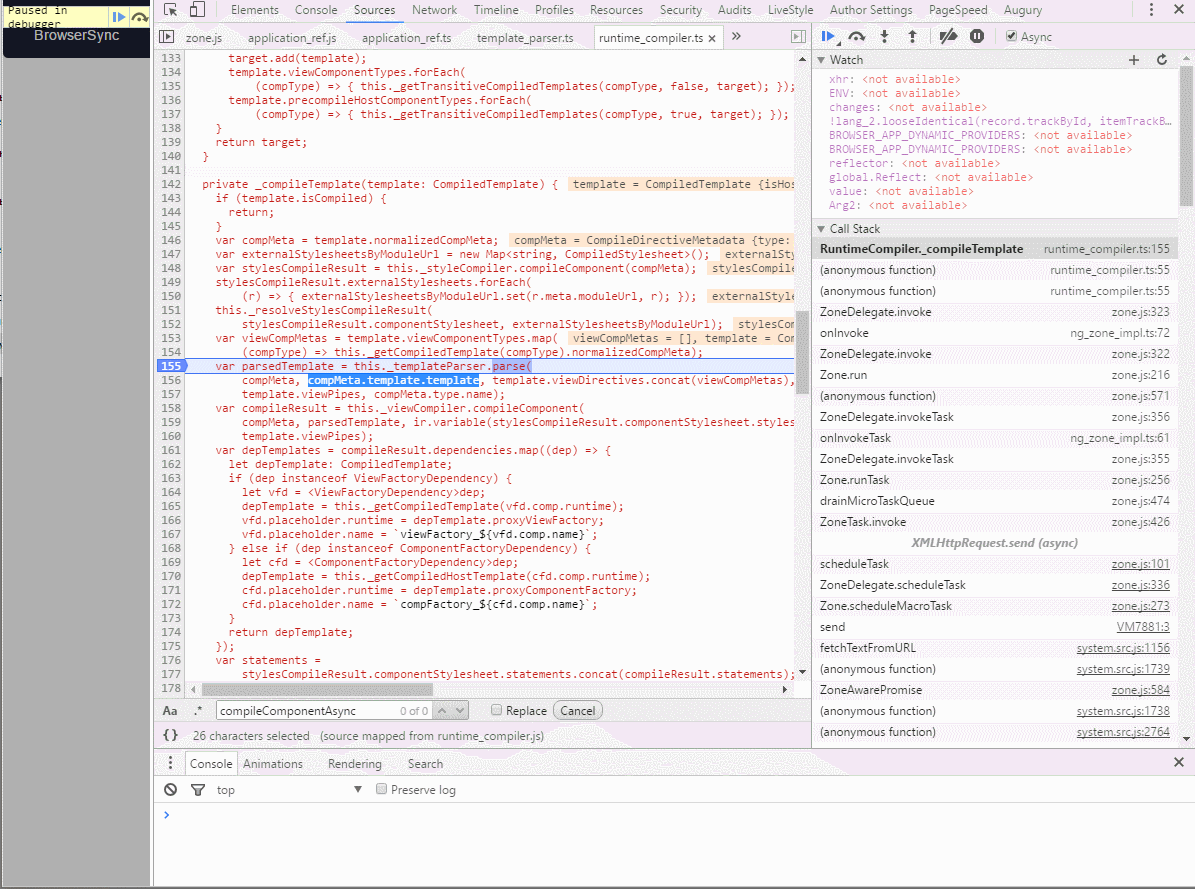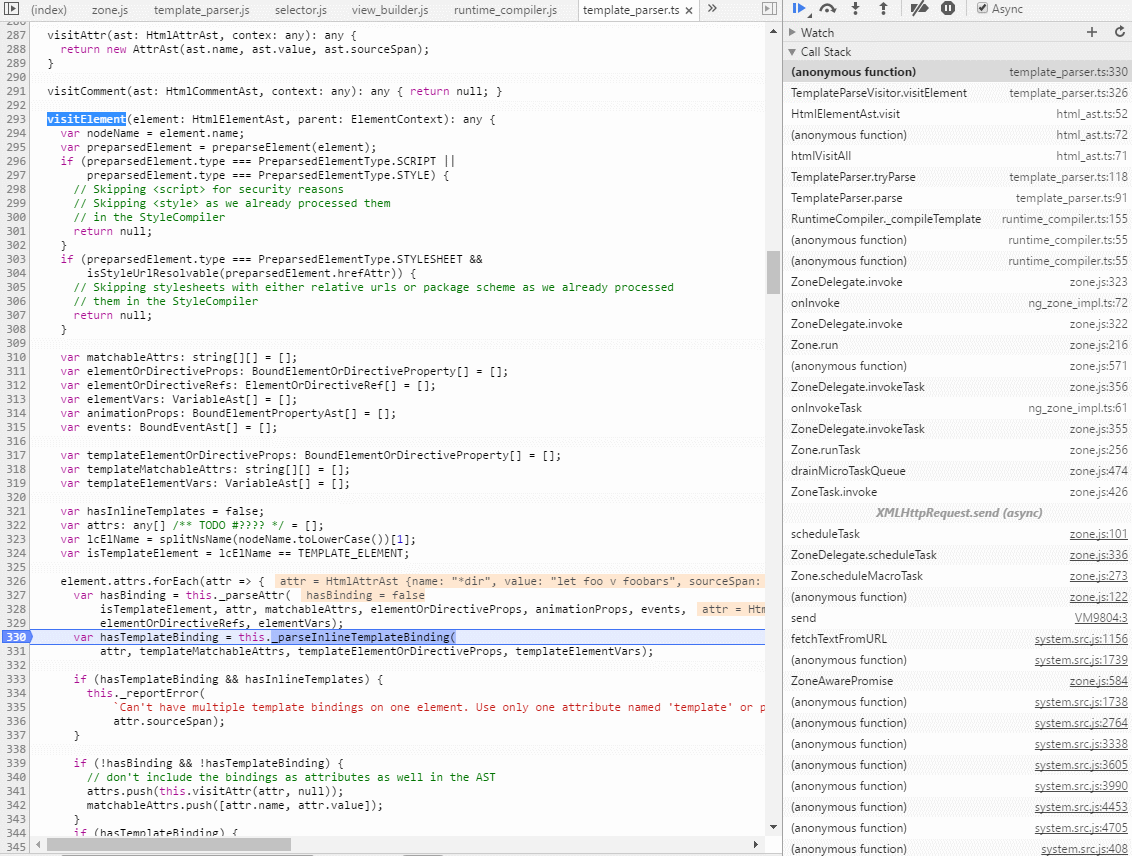I know the textbook rules on that <div *ngFor="let foo of foobars">{{foo.stuff}}</div> turns into <template ngFor let-foo="$implicit" [ngForOf]="foobars"><div>...</div></template>. My question is two-fold:
Ie turn <div *myDirective="item">{{item.stuff}}</div> into <template myDirective let-item="$implicit"><div>{{item.stuff}}</div></template>?
Since I read ngFor's source code top to bottom, I can only assume this dark magic is in the compiler somewhere, I've been up and down the angular github, but I can't put my finger on it. Help!
Yes, all magic happens in the compiler.
Let's take this template:
<div *ngFor="let foo of foobars">{{foo}}</div>
First it will be transformed to the following:
<div template="ngFor let foo of foobars>{{foo}}</div>
And then:
<template ngFor let-foo [ngForOf]="foobars"><div>{{foo}}</div></template>
In Angular2 rc.4 it looks like this

First is generated ast tree node (Abstract Syntax Tree node) and then all magic happens in the TemplateParseVisitor.visitElement(https://github.com/angular/angular/blob/2.0.0-rc.4/modules/%40angular/compiler/src/template_parser.ts#L284) specifically at the bottom (https://github.com/angular/angular/blob/2.0.0-rc.4/modules/%40angular/compiler/src/template_parser.ts#L394)
if (hasInlineTemplates) {
var templateCssSelector = createElementCssSelector(TEMPLATE_ELEMENT, templateMatchableAttrs);
var templateDirectiveMetas = this._parseDirectives(this.selectorMatcher, templateCssSelector);
var templateDirectiveAsts = this._createDirectiveAsts(
true, element.name, templateDirectiveMetas, templateElementOrDirectiveProps, [],
element.sourceSpan, []);
var templateElementProps: BoundElementPropertyAst[] = this._createElementPropertyAsts(
element.name, templateElementOrDirectiveProps, templateDirectiveAsts);
this._assertNoComponentsNorElementBindingsOnTemplate(
templateDirectiveAsts, templateElementProps, element.sourceSpan);
var templateProviderContext = new ProviderElementContext(
this.providerViewContext, parent.providerContext, parent.isTemplateElement,
templateDirectiveAsts, [], [], element.sourceSpan);
templateProviderContext.afterElement();
parsedElement = new EmbeddedTemplateAst(
[], [], [], templateElementVars, templateProviderContext.transformedDirectiveAsts,
templateProviderContext.transformProviders,
templateProviderContext.transformedHasViewContainer, [parsedElement], ngContentIndex,
element.sourceSpan);
}
return parsedElement;
This method returns EmbeddedTemplateAst. It's the same as:
<template ngFor let-foo [ngForOf]="foobars"><div>{{foo}}</div></template>
If you want to turn:
<div *myDirective="item">{{item.stuff}}</div>
into
<template myDirective let-item><div>{{item.stuff}}</div></template>
then you need to use the following syntax:
<div *myDirective="let item">{{item.stuff}}</div>
But in this case you won't pass context. Your custom structural directive might look like this:
@Directive({
selector: '[myDirective]'
})
export class MyDirective {
constructor(
private _viewContainer: ViewContainerRef,
private _templateRef: TemplateRef<any>) {}
@Input() set myDirective(prop: Object) {
this._viewContainer.clear();
this._viewContainer.createEmbeddedView(this._templateRef, prop); <== pass context
}
}
And you can use it like:
<div *myDirective="item">{{item.stuff}}</div>
||
\/
<div template="myDirective:item">{{item.stuff}}</div>
||
\/
<template [myDirective]="item">
<div>{{item.stuff}}</div>
</template>
I hope this will help you understand how structural directives work.
Update:
Let's see how it works (plunker)
*dir="let foo v foobars" => [dirV]="foobars"

So you can write the following directive:
@Directive({
selector: '[dir]'
})
export class MyDirective {
@Input()
dirV: any;
@Input()
dirK: any;
ngAfterViewInit() {
console.log(this.dirV, this.dirK);
}
}
@Component({
selector: 'my-app',
template: `<h1>Angular 2 Systemjs start</h1>
<div *dir="let foo v foobars k arr">{ foo }</div>
`,
directives: [MyDirective]
})
export class AppComponent {
foobars = [1, 2, 3];
arr = [3,4,5]
}
Here is the corresponding Plunker
See also
Live example you can find here https://alexzuza.github.io/enjoy-ng-parser/
If you love us? You can donate to us via Paypal or buy me a coffee so we can maintain and grow! Thank you!
Donate Us With